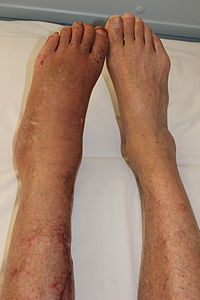
Photo from wikipedia
Abstract Objectives Mechanisms of complex regional pain syndrome (CRPS) are still debated. Identifying subgroups of patients have been attempted in the hope of linking clinical findings to possible mechanisms. The… Click to show full abstract
Abstract Objectives Mechanisms of complex regional pain syndrome (CRPS) are still debated. Identifying subgroups of patients have been attempted in the hope of linking clinical findings to possible mechanisms. The aim of the present study was to investigate whether subgroups of CRPS (based on quantitative sensory testing (QST)-results) differed with respect to different characteristics of pain like spontaneous ongoing or paroxysmal pain and mechanical dynamic allodynia. Methods 61 CRPS-patients (type 1 and 2) were examined clinically and with QST, in affected and contralateral extremity, with assessment of thresholds for warmth, cold and heat-and cold pain. Results 43 patients (20 men, 23 men) were diagnosed with CRPS 1 (70.5%) and 18 patients (8 women and 10 men) with CRPS 2 (29.5%). Three subgroups were defined based on thermal thresholds; A (thermal allodynia 22.9%), B (thermal hyposensitivity 37.3%), C (thermal allodynia and hyposensitivity 39.3%). Paroxysmal pain was more prevalent in patients with thermal allodynia (merging group A + C, 25/38–65.8%) compared to patients without thermal allodynia (group B, 5/23–21.7%) (p-value=0.00085). Conclusions We suggest that cold allodynia is based on hyper-excitability of very superficial skin nociceptors. The correlation between paroxysmal pain, allodynia to light touch and cold allodynia suggests that activity in those peripheral nociceptors can drive both, paroxysmal pain and spinal sensitization leading to stroke evoked allodynia. Mechanistically, the physical cold stimulus can unmask disease-related hyperexcitability by closure of temperature-sensitive potassium channels or induction of resurgent currents. Small fiber degeneration alone may not be the crucial mechanism in CRPS, nor explain pain.
Journal Title: Scandinavian Journal of Pain
Year Published: 2022
Link to full text (if available)
Share on Social Media: Sign Up to like & get
recommendations!